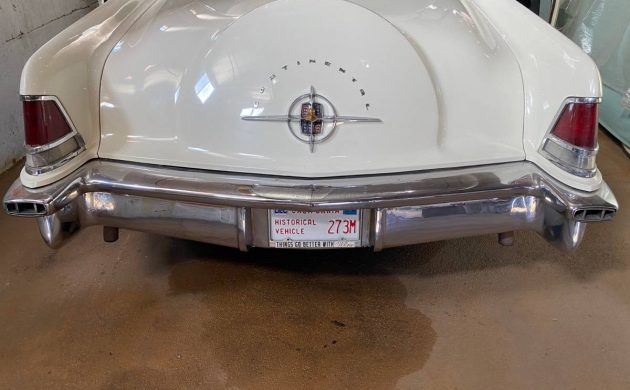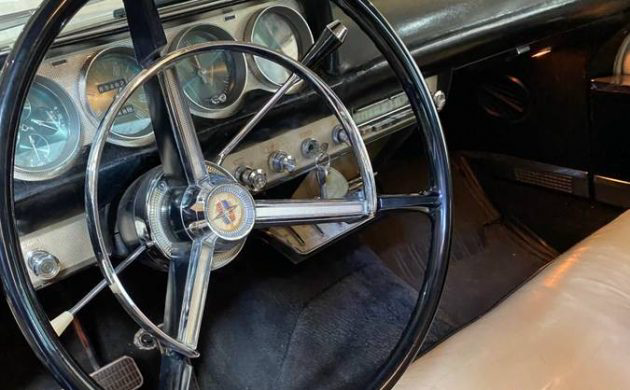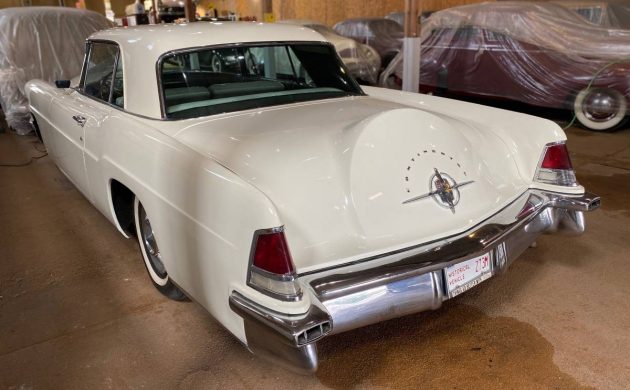Do cars belong in museums? It is an interesting topic, and it will ignite views from both sides of the fence. While I deem it essential to preserve classic cars, I always feel that they deserve an opportunity to grace our roads rather than the inside of a museum. This 1957 Continental Mark II is the second vehicle of this type that I’ve had the privilege to write about in the last few days. The first was this 1964 Lincoln Continental, which is sitting in the same museum. The time has come for this Mark II to gain its freedom, so the owner has listed it for sale here on Craigslist. It is located in Hollister, California, and the owner has set the sale price at $38,500. I again need to thank Barn Finder MattR for spotting this remarkable survivor for us.
The Continental Mark II was an exercise in excellence. The company’s stated aim was to build the best American car that money could buy. Therefore, their quality control program was head and shoulders above anything offered by any other manufacturer at that time. While many have succumbed to rust problems over the years, a surprising number have survived intact. A life spent as a museum piece sees our feature car remarkably well preserved. Its Starmist White paint shines impressively, with only a few minor flaws and defects. It graces panels that are as straight as an arrow, with consistently tight gaps. There is no evidence of any rust problems, and the seller mentions none in his listing. The external trim and chrome are in acceptable condition for a survivor-grade car, but the bumpers would benefit from a trip to the platers if they are to be lifted to the next level. The best example of the level of care and attention lavished on the Mark II is exemplified by its hubcaps. Continental could have produced some nice pressed steel items and applied chrome, but the company deemed that approach as unacceptable. Instead, the ones that found their way onto the Mark II were hand-assembled, with a technician attaching each of its distinctive vanes to the center and the outer edge of the cap individually. The Continental features tinted glass, and this looks flawless.
In keeping with its luxury leanings, the Mark II was one of the most highly equipped cars to roll out of an American factory at that time. Owners received leather upholstery, power windows, power vent windows, a power front seat, full instrumentation, an AM radio, and a low fuel level light. Apart from paint and trim, the only other decision that a buyer made was whether or not to include air conditioning for an additional $595. It appears that the original owner ticked that box on the Order Form, making this Continental as highly equipped as was possible. The overall condition of the interior is pretty good for a survivor. There is some wear and drying on the leather upholstery, and it would be interesting if the buyer gained an opinion from a leather specialist as to whether they could revive it. There are no rips or tears, so it remains serviceable as is. The rest of the upholstered surfaces are in good order, as is the dash. With the seats rejuvenated, this interior would present nicely.
The lack of decisions for potential buyers continued under the hood. Standard equipment included a 368ci V8, a three-speed “Turbo-Drive” automatic transmission, power steering, and power brakes. If potential buyers weren’t thrilled with that combination, they needed to look elsewhere because that was the only one available. With 300hp on tap, that V8 could launch the 4,980lb Continental through the ¼ mile in 17.1 seconds. Considering that the company designed this purely as a luxury car, that figure remains impressive. It appears that potential buyers won’t need to do much to return this classic to a roadworthy state. The seller indicates that the Mark II runs and drives but requires an exhaust. If it has been sitting for a while, it would be worthwhile to send it off for a thorough inspection. After all, it is better to be safe than sorry. However, it doesn’t look like it’s going to cost a lot of money to return this Continental to its rightful place on our roads.
While 3,005 examples of the Continental Mark II rolled out of the factory, only 2,989 were production examples once we remove the prototypes and pre-production vehicles from the equation. The company intended to build the best American luxury production car possible, and their quality control measures ensured that they succeeded. However, Ford deemed these cars too expensive and revealed that even at the sticker price, they lost around $1,000 on each sale. Therefore, the Mark II signaled the end of the genuine handbuilt Continentals. Some have succumbed to the rust problems that plagued many vehicles from this era, but this car has avoided those problems. Its time in the museum has allowed it to remain remarkably well preserved, but it is also time that it saw active duty on our roads once again. Are you going to be the person that makes that happen?






Honestly, stop quoting quarter-mile times on these types of cars. Chargers, Corvettes, OK, fine. But a ’57 Lincoln? It’s meaningless and frankly it’s annoying. Nobody cares about, or compares that statistic with other cars of this vintage anyway. Who drags a ’57 Lincoln? And who cares how fast it would run the quarter circa 1957?
Honestly, there’s a lot more to write about this car than how fast it will go down the track The writing is getting a bit too formulaic.
Son your gonna drive me to drinkin if you don’t quit drivin that hot rod Lincoln
ditto Daniel , these were the luxury hot rods of the fifties, don’t build them lighter, more cubic inch motors solved that problem, I like knowing the 1/4 mile times. respect where we came from, don’t cancel something just you think it’s not right.
Dwight Eisenhower had a white ’57.
Striking cars, but the dash always struck me as quite angular for the ’50’s
Yes, but what was Dwight’s quarter mile time?
Schrute or Eisenhower???
I like knowing the quarter mile times as it gives a relative measure for a given drive train. I also think museum cars are a great way for the public to see interesting or noteworthy cars. Shows these days are just endless rows of trucks and muscle cars.
I like it too.
Always an interesting additional point of comparison. It positions performance against contemporaries or current contenders.
It certainly doesn’t hurt anything but perhaps some nostalgic egos…
Looks like it’s at the same museum as the blue 64.
Such beautiful cars.
I also think the 1/4 mile times make no sense on half the vehicles here. Although popular mechanics always included it regardless…
Regardless of the car I am always disappointed when 1/4 miles are not included. I love the relative comparison from car to car and decade to decade. Even if I didn’t care about it l was raised a little better than to blast someone doing their job.
Prices of these have really declined. Not a big market for them and it’s getting smaller by the day as fewer and fewer remember or want them. Impressive cars, regardless. But they are huge and if you are looking for a FoMoCo cruiser from that era, an early T-bird might be a better fit for about the same money.
I have said it before and will again. Each passing day, we get older as does everything else. People who remember these cars from the 50s are getting old. Therefore, either they no longer drive or need money for medical reasons. The demand for these cars is low, while everybody wants a buckboard riding POS 66 to 77 Bronco. I will never understand it, but such is life. Wait a few more years and this beautiful Lincoln will be say, $20,000.
If you’re wore about the quarter mile you’re doing it wrong.
Keep in mind that most car museums are not really museums. They are tax shelters for wealthy car collectors. Wealthy car collectors don’t buy cars for themselves; no, they “donate” vehicles to the non-profit museums they create. Also, as “curators”of these “museums”, they get to drive, store, and maintain these vehicles at the museum’s expense. And when the “curator” is bored with a particular car, the “museum” sells it off and gets something else. The “museum” doesn’t have to worry about recording a gain on the sale, because it is a nonprofit! Also, these “museums” almost never make enough in admissions to cover costs, so there is no fear of running afoul of tax laws. So, when you hear about a car museum closing somewhere, don’t be sad. It’s just some old rich guy who has passed on.
I wonder if that is how “Jay Leno’s Garage” is run?
I am a member of two local auto museums; one is specifically oriented around one individual collector’s assemblage, and the other was constructed around several collectors’ vehicles.
Each operates differently; one enjoys rotating exhibitions of loaned and owned, while the other is mostly a static display collection with occasional offshoots. One sponsors and operates a wonderful annual concours. Both are ingrained into storage of private vehicles, creating more income than simple admissions.
As a member, it doesn’t faze me how or why they were established; we get to see some really fascinating vehicles that would otherwise remain unknown or invisible to me.
The museum where I volunteer is quite different from your description and I hope others are as well. About half of our collection are privately owned and the other half are owned by the museum. Nobody is rich here. Several hundred volunteers were very hard to keep the museum open And about 150 cars in top mechanical and cosmetic condition. We take people for rides in some of our cars and display them and various events in the area. Our sources of income Things like car sales and event rentals. The museum receives no public funding outside of an occasional grant.
To redo the exhaust properly to exit thru bumper will probably run next owner about $3000
It’s actually worse than you think. I have one of these cars and the exhaust is routed through the outer frame rails to the rear of the car and exits then goes up through the bumper. Mine is I think in stainless but I’d hate to have to replace it.
Looks like 4 bodies will fit in the trunk maybe 5 if you remove the spare tire. This would be a nice car to just cruise around in
Rodney, I can accurately state that Dwight went from zero to 60 in exactly 59 years and 12 months.
Yeah Quit giving us actual facts and specs. Just say “and they were pretty fast”. That would be better.
There are all sorts of private collections of cars (and art work) held out as “charities” to get the tax benefits – no income tax on the “profiits” which rarely happen – but income tax deductions for charitble donations for the donor who keeps “control” of the museum in fact, but not in name, since that would run afoul of the tax laws. The IRS used to have a robust charitible review capacity which is now diminished and so they do not audit these things like they used to. What often happens is that the rich guy who starts these dies, the asset is just cars, a group of well meaning souls take over, and have to sell half the collection to fund the running of a museum for the rest, or, the collection is just liquidated, money is used to pay back loans to the founder’s estate that were used to keep it running. Jay Leno has been quoted, maybe correctly, maybe not, that he has made no provisions for the continuance of his collection – so it probably will go to BJ or another high end auctioneer for the auction of the century. Bill Harrah’s collection in Nevada was about halved to provide funds for the rest, as was a much smaller collection in Maine, much of the best of each still survive in a real non-profit charitble museum. So sometimes it works out for the public, and sometimes it does not.
I would love to own one of these. However I need to sell one to make room.
“You’re going to need a bigger boat”.
https://youtu.be/QT9BeGNnCqw
Wasn’t any more “hand-built” than any other Ford, really.
I have a mark II similar to this. Also Starmist White but with tan interior. The seats in mine are in the same condition or perhaps even worse. The cars were hand assembled but were not hand built. They have adequate acceleration for todays traffic. For smoothness the transmission starts off in second gear only. Low gear is available but clumsy to shift back and forth. So it’s like a power glide in a sea of ten speed SUVs and trucks. There is a wonderful Mark II Forum on the internet that provides endless amounts of information and support. I hate that these very rare cars are worth less than they probably should be but it makes them more affordable for most of us.
This Lincoln is just beautiful!! However, if you’re punching it to see what it can do in a quarter mile, I wouldn’t be interested. A car like this, or any other classic or antique should be getting white glove care!!!’
A friend bought a musuem Model T, they sit, and more n’ likely not “pickled”
right. He put more into it then he paid for it and it still doesn’t run right. Didn’t ask me,I told him to advertise in our local cemetaries
After 64 years, the design still looks fresh.
So no pictures of the front end in the Craigslisting. What gives with that? One of the most impressive features of this car is the massive grille. My uncle Bob, an LA Fire Chief in the 50s, bought one of these new, a white one. Maybe this was his. Impressive car.
@Ron. You might want to check your facts. This was never a Lincoln, really.
whada car ! Iconic I’d say. Tops w/a late ’50s 350SL I’d say